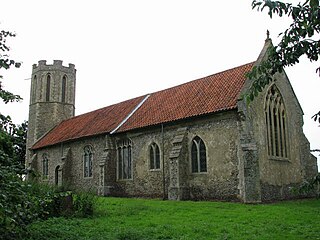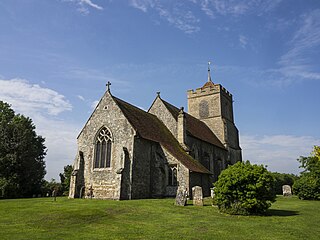
The Church of St Katharine of Alexandria is the Church of England parish church for Ickleford in Hertfordshire. It comes under the diocese of St Albans. [1]
Contents
The building is of medieval origin and is listed Grade I. [2]

The Church of St Katharine of Alexandria is the Church of England parish church for Ickleford in Hertfordshire. It comes under the diocese of St Albans. [1]
The building is of medieval origin and is listed Grade I. [2]

Ickleford is not mentioned in the Domesday Book probably because it was part of Pirton. [3] The church of Ickleford was originally a chapel to Pirton, and the two livings were held together until divided by order of the Ecclesiastical Commissioners in 1847. The advowson was purchased by Thomas Wilson in 1868. It was conveyed before 1875 to the Rev. T. I. Walton, and then belonged to the Rev. C. A. Walton, his son. [4]
A small church in the centre of Ickleford, the nave dates to the mid 12th-century, while the chancel and West tower are from the early 13th-century. The South porch and nave roof were added in the mid 15th-century. The church underwent a major restoration in 1859 under Sir George Gilbert Scott at which time the South aisle, South chapel (currently in use as the organ chamber) and North vestry were added. The external masonry walls are plastered while the walls of the South clerestory are of uncoursed knapped flint. The chancel has a 13th-century lancet window to the North of the altar, a 15th-century cinquefoil piscina to the South, and stained glass of about 1860 attributed to Clayton and Bell in a medallion and mosaic design. [2] [4] [3]
In the South wall is a wide 19th-century Romanesque arch with interlinked chain motif, while on the North wall there is a large monument to Richard Ansell of 1726 and which is signed by R. Easton. There are funerary hatchments over the North and South doors and an octagonal 19th century arcaded stone pulpit matched by an octagonal stone baptismal font on eight coloured marble shafts, both added during the restoration by Scott. There is a monumental brass of Thomas Somer and his wife Marjory of about 1380 with an imperfect inscription. The church has a stained-glass window of 1898 by Charles Eamer Kempe. [2] In the north wall of the nave are two windows, one on each side of a blocked 12th-century Norman doorway which is damaged and has been repaired with cement, but which has a well-preserved chevron moulding on the rear-arch. [4]

The West tower is of two stages with heavy buttresses, those at the north-west and south-west angles being diagonal. The low pyramidal roof is of lead. The tower arch, which is two-centred, and a small lancet on the south side, are probably original. The west window and the two-light belfry windows are of the 15th-century and are repaired with cement. There are five bells: the treble and second are by John Warner & Sons, 1857; the third is by Richard Chandler, 1680; the fourth by Miles Graye, 1650; and the fifth by Thomas Russell of Wootton, 1726. [4]
The plate consists of a cup of 1796, presented by Thomas Cockayne in 1807 and a Victorian paten and flagon, the former made from two old silver patens. The high altar is of oak which is panelled and carved. The gilded and painted triptych behind the altar shows the worship of Jesus as the King of Heaven; it is Gothic in design and is by Charles Edgar Buckeridge.
The church is the burial-place of Henry Boswell, "King of the Gypsies", who died in 1760, at the advanced age of 90; the remains of his wife and granddaughter are likewise interred here.
The church has been listed by English Heritage as a Grade I listed building since 1968. [2]

Battlesden is a hamlet and civil parish in the Central Bedfordshire district of Bedfordshire, England. It is just north of the A5, between Dunstable and Milton Keynes. According to the 2001 census, it had a population of 38. Because of its low electorate, it has a parish meeting rather than a parish council. It is in the civil parish of Milton Bryan.

St Andrew's Church is a redundant Anglican church in Cranford St Andrew, Northamptonshire, England. It is recorded in the National Heritage List for England as a designated Grade II* listed building, and is under the care of the Churches Conservation Trust. The church stands in the park of Cranford Hall, to the southwest of the house.

St Michael and All Angels Church is a redundant Anglican church in the village of Edmondthorpe, Leicestershire, England. It is recorded in the National Heritage List for England as a designated Grade I listed building, and is under the care of the Churches Conservation Trust.

St Mary's Church is a redundant Anglican church in the village of Shipton Sollars, Gloucestershire, England under the care of The Churches Conservation Trust. It is recorded in the National Heritage List for England as a designated Grade I listed building,

St Martin's Church is a redundant Anglican church in the village of Waithe, Lincolnshire, England. It is recorded in the National Heritage List for England as a designated Grade I listed building, and is under the care of the Churches Conservation Trust. It stands in open countryside near the A16 road between Grimsby and Louth.

St Mary's Church is a redundant Anglican church in the village of Alvingham, adjacent to the village of North Cockerington, Lincolnshire, England. It is recorded in the National Heritage List for England as a designated Grade I listed building, and is under the care of the Churches Conservation Trust.

St Mary's Church is a redundant Anglican church in the village of Barnetby, Lincolnshire, England. It is recorded in the National Heritage List for England as a designated Grade I listed building, and is under the care of the Churches Conservation Trust.

All Saints' Church is a redundant Anglican church in the village of Icklingham, Suffolk, England. It is recorded in the National Heritage List for England as a designated Grade I listed building, and is under the care of the Churches Conservation Trust. The church stands in the highest point in the village, adjacent to the A1101 road between Mildenhall and Bury St Edmunds. This was formerly the ancient trackway of Icknield Way, and Icklingham is close to an important junction on this trackway.

St Mary's Church is a redundant Anglican round-tower church near the village of Moulton St Mary, Norfolk, England. It is recorded in the National Heritage List for England as a designated Grade I listed building, and is under the care of the Churches Conservation Trust. It stands some 4 kilometres (2 mi) to the south of Acle in an isolated position adjacent to a farm.

St Peter's Church is a redundant Anglican church in the village of Normanby by Spital, Lincolnshire, England. It is recorded in the National Heritage List for England as a designated Grade I listed building, and is under the care of the Churches Conservation Trust. The church stands close to the former Roman road, Ermine Street, now the A15 road.

All Saints Church, Saltfleetby, is a redundant Anglican church in the village of Saltfleetby All Saints, Lincolnshire, England. It is recorded in the National Heritage List for England as a designated Grade I listed building, and is under the care of the Churches Conservation Trust. The church stands in the marshland of Lincolnshire, and has a leaning west tower.

St Nicholas Church is a redundant Anglican church in the village of Buckenham, Norfolk, England. It is recorded in the National Heritage List for England as a designated Grade I listed building, and is under the care of the Churches Conservation Trust. The church stands among fields to the north of the River Yare.

All Saints Church is a redundant Anglican church in the village of Little Wenham, Suffolk, England. It is recorded in the National Heritage List for England as a designated Grade I listed building, and is under the care of the Churches Conservation Trust. It stands in an isolated position close to Little Wenham Hall, about 0.6 miles (1 km) to the northwest of Capel St. Mary.

St Andrew's Church is a redundant Anglican church in the village of Buckland, Hertfordshire, England. It is recorded in the National Heritage List for England as a designated Grade II* listed building, and is under the care of the Churches Conservation Trust. The church stands at the highest point in the village to the east of Ermine Street, now the A10 road, between Royston and Buntingford.

St Helen's Church is a redundant Anglican church in the village of Little Cawthorpe, Lincolnshire, England. It is recorded in the National Heritage List for England as a designated Grade II listed building, and is under the care of the Churches Conservation Trust. Little Cawthorpe is about 1 mile (1.6 km) southwest of the village of Legbourne, and 3 miles (4.8 km) southeast of Louth.

St Nicholas' Church, Sturry, is a joint Anglican and Methodist church standing on a bank beside the River Stour, in the village of Sturry, near Canterbury, in East Kent. The Local Ecumenical Partnership enables the congregation to be of mixed denomination - either Methodist or Anglican.

St Eugrad's Church, Llaneugrad is an isolated church near the village of Marian-glas, in Anglesey, north Wales. A church was supposedly founded here by St Eugrad in about 605, although the earliest parts of the present structure are the nave, chancel and chancel arch, which date from the 12th century. A side chapel was added to the north in the 16th century, and some moderate restoration work was carried out in the 19th century. It contains a 12th-century font, a 13th-century carved stone depicting the crucifixion, and a memorial to one of the officers killed when the Royal Charter sank off Anglesey in 1859.

St Laurence's Church is in the village of Morland, Cumbria, England. It is an active Anglican parish church in the deanery of Appleby, the archdeaconry of Carlisle, and the diocese of Carlisle. Its benefice is united with those of St Mary, Thrimby, St Barnabas, Great Strickland, and St Cuthbert, Cliburn. The church is recorded in the National Heritage List for England as a designated Grade I listed building. It has the only Anglo-Saxon tower in Cumbria.

St Nicholas' Church is a Grade I listed parish church in the village of Berden, Essex, England.

St Margaret's Church is a 13th-century Church of England church in the village of Whaddon, Gloucestershire, England. It has been a grade II* listed building since 10 January 1955. The church tower is a dominant feature within the surrounding flat area.